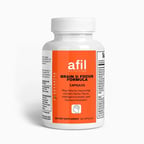Iron (Oxide)
Iron oxide is a poorly absorbed iron compound found in cosmetics, supplements, and fortified foods. It may cause gut irritation, inflammation, or immune reactions in sensitive individuals. Avoid for 8 weeks, support detox, and reassess for symptom relief.
🧲 What is Iron Oxide?
Iron oxide is a compound of iron and oxygen found naturally as rust or in minerals. It’s commonly used as a colorant in cosmetics, supplements, paints, and food coatings, and also appears in industrial dust and iron-fortified products. While generally considered safe in trace amounts, some people may develop intolerance or sensitivity to iron oxide due to poor detox capacity or immune reactivity.
🤔 Why Do I Have a Sensitivity to Iron Oxide?
Iron oxide sensitivity typically results from accumulation, poor absorption, or inflammatory response, especially when exposure is frequent. Here's why it might be affecting you:
-
Poor Bioavailability – Iron oxide is poorly absorbed, especially when taken as a supplement. This can cause gut irritation without benefiting your iron levels.
-
Inflammatory Potential – In sensitive individuals, iron oxide may contribute to oxidative stress, triggering symptoms like fatigue, headaches, brain fog, or joint discomfort.
-
Immune System Reactivity – Iron oxide can act as an irritant, especially when inhaled in dust form or applied topically (in makeup or skincare), leading to skin rashes, itching, or respiratory symptoms.
-
Excess Iron Storage – In people with impaired iron metabolism, iron oxide can add to the body’s total iron load, increasing risk for inflammation and oxidative damage.
-
Chemical Sensitivity – Those with multiple chemical sensitivities may react to iron oxide pigments or coatings, especially in lipsticks, vitamins, or processed foods.
🛠️ What Can I Do About It?
To support recovery and reduce your sensitivity:
-
Avoid products containing iron oxide for at least 8 weeks, including cosmetics, supplements, and fortified foods.
-
Choose iron-free or food-based supplements if iron support is needed.
-
Read ingredient labels carefully, especially on makeup, skincare, and multivitamins.
-
Support your detox pathways with antioxidant-rich foods, hydration, and gut support.
-
Retest after 8 weeks to check for symptom changes.
💊 Which Supplements Can Help with an Iron (Oxide) Sensitivity?
- Vitamin C – Enhances iron absorption while reducing oxidative stress.

- Magnesium – Supports digestion and helps ease constipation caused by iron.

- Zinc – Balances iron metabolism and supports immune function.

- Probiotics – Improves gut health, aiding iron absorption and reducing inflammation.

- NAC (N-Acetyl Cysteine) – Supports detoxification in cases of iron overload.
🌟 Why Might I React to Iron Oxide but Not to Iron or Other Heavy Metals?
-
Poor Absorption = Gut Irritation
Iron oxide is poorly bioavailable, so your body doesn’t absorb it well. This can cause it to linger in the gut, irritating the digestive lining and leading to symptoms like bloating, nausea, or discomfort—less common with better-absorbed forms like ferrous bisglycinate or food-based iron. -
Immune or Histamine Sensitivity
Iron oxide is used as a pigment in supplements and cosmetics. Some people develop immune sensitivity or mast cell activation in response to it, causing rashes, itching, flushing, or brain fog, even when other forms of iron are well tolerated. -
Different Chemical Form = Different Reaction
Iron oxide is a compound of iron and oxygen, not the same as nutritional iron. The oxidized form may act as an irritant or inflammatory particle, especially when applied to skin or inhaled as dust. -
Inhalation Exposure vs. Ingested Iron
Exposure to iron oxide dust in industrial environments can enter your lungs and trigger respiratory inflammation—something dietary iron doesn’t typically cause. -
Chemical Sensitivity or MCS
If you have multiple chemical sensitivity (MCS), your body may overreact to inactive compounds like iron oxides, particularly when combined with other synthetic ingredients in supplements or cosmetics. -
Additives and Coatings in Products
Iron oxide is often found alongside binders, dyes, and preservatives in tablets and cosmetics. Your symptoms may stem from the overall chemical load, not just the iron oxide alone.
Common Sources of Iron Oxide
-
Iron-fortified cereals and processed foods
-
Cosmetics (foundation, blush, lipstick, eyeshadow)
-
Supplements (especially iron tablets or multivitamins)
-
Tattoo inks and some natural pigments
-
Industrial dust (metalwork, mining, construction)
Alternatives (if tolerated):
-
Iron-free supplements or whole-food-based vitamins
-
Clean, mineral-free makeup brands (look for iron oxide-free formulas)
-
Non-fortified foods and natural skincare options
-
Stainless steel or ceramic tools in place of oxidized metals
.png?width=100&height=75&name=AFIL%20Logo%20(1).png)